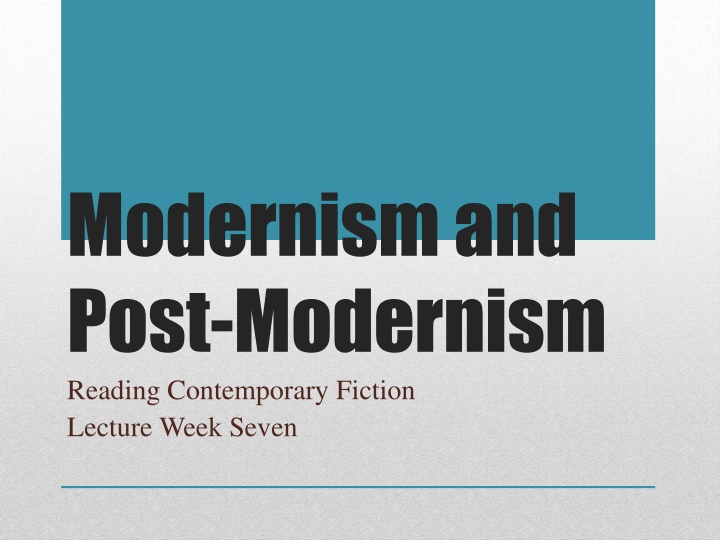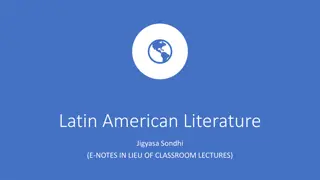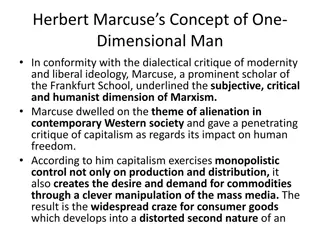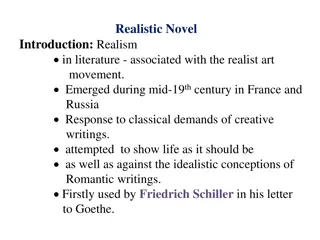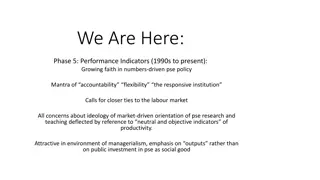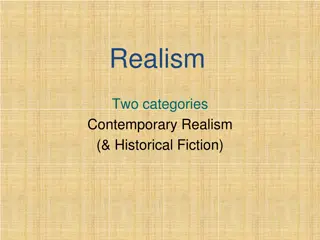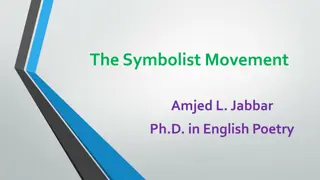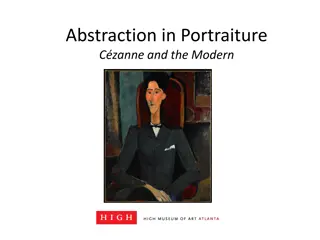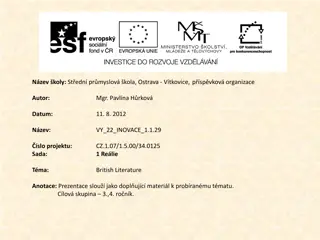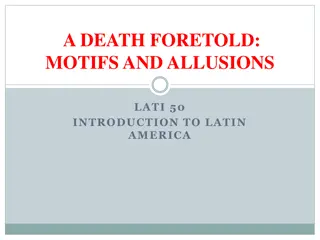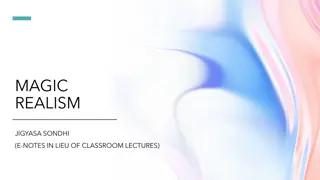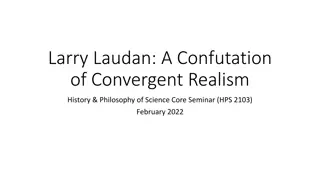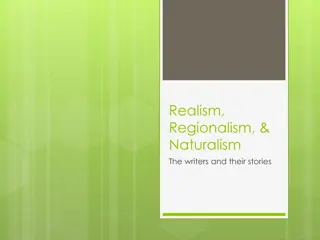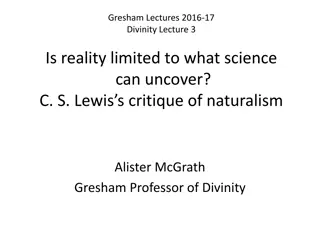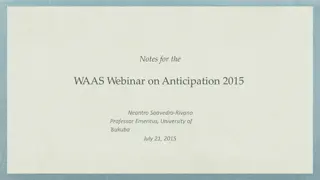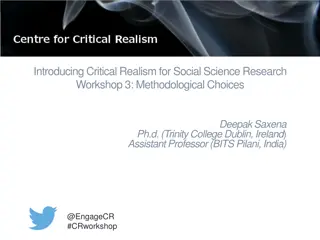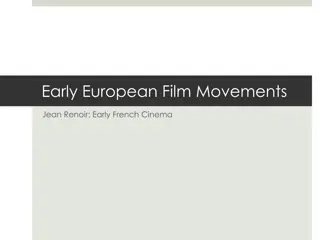Insights into Realism and its Critiques in Literature
Exploring the dominance of realist fiction in European literature, this content delves into the evolution of realism during the Enlightenment period, emphasizing its focus on mimicking social reality. It details the concept of mimesis and verisimilitude in creating a realistic narrative structure that facilitates character development and moral discernment. Additionally, critiques of classic realism are discussed, highlighting the ideological underpinnings and the distinction between literary representation and actual reality.
Uploaded on Sep 02, 2024 | 0 Views
Download Presentation

Please find below an Image/Link to download the presentation.
The content on the website is provided AS IS for your information and personal use only. It may not be sold, licensed, or shared on other websites without obtaining consent from the author.If you encounter any issues during the download, it is possible that the publisher has removed the file from their server.
You are allowed to download the files provided on this website for personal or commercial use, subject to the condition that they are used lawfully. All files are the property of their respective owners.
The content on the website is provided AS IS for your information and personal use only. It may not be sold, licensed, or shared on other websites without obtaining consent from the author.
E N D
Presentation Transcript
Modernism and Post-Modernism Reading Contemporary Fiction Lecture Week Seven
Realism, a brief recap. Modernism Modernist Fiction Post-Structuralism and Post-Modernism A Post-Modern text: 500 Days of Summer Structure of the lecture
In week three we looked at the features of a realist text. Realist fiction became the dominant literary form in Europe in the first half of the nineteenth century (Walder, 1996, p.4). Realism flourished during the Enlightenment; the period of time in which scientific rationality became the dominant way in which humans made sense of the world around them. Morris suggests that traditionally realism has been viewed as a representational form which was concerned with the close artistic imitation of social reality (Realism 4-5). Thus, Morris argues, the term has been linked with notions such as mimesis and verisimilitude (p. 5). Realism
Mimesis: a concept linked to mime and imitation. Also linked to verisimilitude. Verisimilitude: likeness to truth, and therefore, the appearance of being true or real, even when fantastic . . . an acceptable presentation of reality (Dictionary of Literary Terms and Literary Theory) As Morris suggests, the realist plot is typically structured upon the epistemological progress of readers and principal characters from ignorance to knowledge, and characterisation normally focuses upon the highly individualised inner subjective, self-development of rational understanding and moral discrimination (Realism 28).
Classic realism, still the dominant popular mode in literature, film and television drama, roughly coincides with the epoch of industrial capitalism. It performs . . . the work of ideology, not only in its representation of a world of consistent subjects who are the origin of meaning, knowledge and action, but also in offering the reader, as the position from which the text is most readily intelligible, the position of subject as the origin both of understanding and of action in accordance with that understanding (Critical Practice 67) . Critiques of Realism
Morris: There is one distinction between realist writing and actual everyday reality beyond the text that must be quite categorically insisted upon: realist novels never give us life or a slice of life, nor do they reflect reality . . . realism is a representational form and a representation can never be identical with that which it represents ([emphasis in original] 4). Critiques of Realism
Modernism, in the infrastructural productive sense, begins in the 1890s and 1900s, a time which experienced mass technological innovations, the second tidal wave of the Industrial Revolution begun nearly a century before. New Technology (automobile, tractor, bus, aeroplane, telephone, typewriter) Mass Media and Entertainment (advertising and mass circulation newspapers, gramophone, wireless telegraph, gramophone, movie theatres) Science (genetics, psychoanalysis, theories of the atom, and of relativity) (Appignanesi and Garratt, 1998, p.11) Modernism
What we see here is nothing less than a new way of looking at the world. The world itself becomes inter- connected due to advances in science and technology. Freud s theory of consciousness also has radical implications for how the human subject sees itself. For the first time in history, humans have the sense of themselves as having a psyche with different levels of consciousness: the conscious, the subconscious and the unconscious minds. What effect do you think this might have had on writers and/or artists? Modernism
Marx and Engels The Communist Manifesto 1848 Darwin The Origin of the Species 1872 Freud The Interpretation of dreams 1899 Einstein Relativity 1916 World War 1 1914-1918 The modernist context
Virginia Woolf, Mrs Dalloway, To the Lighthouse, The Waves James Joyce Ulysses T.S. Eliot The Wasteland Samuel Beckett Waiting for Godot For writers such as Virginia Woolf and James Joyce, the problem with the realist form is that it does not accurately represent reality as it is experienced. Woolf writes: Life is not a series of gig-lamps symmetrically arranged; life is a luminous halo, a semi-transparent envelope surrounding us from the beginning of consciousness to the end. Is it not the task of the novelist to convey this varying, this unknown and uncircumscribed spirit, whatever aberration or complexity it might display, with as little mixture of the alien and external as possible? (Collected Essays: Volume Two 106) She suggests that reality cannot be contained any longer by such ill-fitting vestments as [novelists] provide (Collected Essays: Volume Two 105). What does she mean by this? Modernist Fiction
Morris uses the example of Mrs Dalloway to show how Woolf breaks with the conventions of realism prevalent in her time: plot is encompassed in a single day and resolves no mysteries, leaves the future of the lives presented in the story as uncertain as at the beginning, and refuses the reader any objective knowledge of the main protagonists that could form the basis of moral or epistemological evaluation. Put in technical terms, the novel refutes closure: nothing and no one is summed up in the writing as a coherent truth that can be known. ([emphasis in original] 15) What we see here is that Woolf applied her critical ideas about fiction and pioneered a new style of writing. Her critique of realist fiction was that it didn t actually reflect reality. Virginia Woolf
Much of the fiction that comes after Woolf and Joyce is influenced by their ideas. Many writers take their ideas forward and produce different kinds of texts. The two short stories for this week The Balloon and How I contemplated my life . . . are clearly not realist texts. Both these stories are also influenced by the post- structural critique of language. This theoretical critique changes the way that texts are written, read and studied. Cultural Studies (and current Literary Studies) owes a great debt to the work of writers such as Joyce and Woolf and thinkers such as Jacques Derrida and Roland Barthes (amongst others). Post-Modern Fiction
Structuralists would argue is that there is nothing about the word cat or the idea of a cat which means cat. Put another way, they believe the SIGN is relational and dependent on the relationship between the signifier and the signified. There is nothing about the word or the concept that universally implies the characteristics of a cat. Cat is an English word; in Italian it is gatto , in French it is chat . Post-structuralism is a critique of structuralism and has its hey-day in the late 60s and early 70s. Ferdinand de Saussure, a linguist, posited that language is organised like a system. For Saussure signifiers and signified make up the SIGN (the meaning of the word) So, cat (the word) + cat (the concept: the idea we get when we see or hear the word) = sign. Structuralism
Jacques Derrida uses structuralism to point out that a texts meaning is relational. For Derrida, meaning is endlessly deferred. Or, to put it more simply, what happens if we look up the word table in the dictionary? Another way of thinking about it is through binaries. It is almost impossible to define the word cold without invoking the concept of hot . Post-Structuralism: Derrida
Derridas formulation of deconstruction has been one of the most important ideas in post-structural literary theory. Derrida posits that if we deconstruct a text which for the purposes of this unit means seeing who is represented in the text and who is absent - we can understand more about the text and the culture it was created in. We can reveal meanings in the text that the author may not have intended. Deconstruction is an important tool for Cultural Studies and Literary Criticism. When applied to the Literary Canon it allows us to see whose work is valued and whose has been ignored. Post-Structuralism: Derrida
Another central idea of post-structuralism is Roland Barthes assertion in 1967 that the author is dead . What might this mean? For Barthes, the death of the author means that all readers bring their own meaning to a text. He makes a distinction between the readerly text (a text whose interpretation is straightforward and determined by the author) and the writerly text (an open text, which invites the reader to make up their own meaning). The work of Derrida and Barthes has been critical in literature. The period immediately after this post-structuralist critiques is rife with experimental writing, which has often been labelled post- modern. Post-Structuralism: Barthes
Post-modernist writers include Donald Barthelme, Carol Shields, Thomas Pynchon, Margaret Atwood, A.S. Byatt, Samuel Beckett, Yann Martel, Arundhati Roy and Dave Eggers amongst many, many others. If postmodernism has proved a synthetic discourse, unanimated by personal concerns, at least it has given writers a breath of that precious oxygen of permission, and more important, time to see in what ways the old realism the mirror of the world has failed us. It was perhaps, not real enough. (Carol Shields: Narrative Hunger and the Possibilities of Fiction 34) Post-Modern Fiction
Is this a postmodern text? Why is it a postmodern text? What does it have in common with other postmodern fiction? 500 Days of Summer
Appegnanesi, Richard and Chris Garrat, 1998. Introducing Postmodernism, Icon Books: Cambridge Glendinning, Simon, 2011. Derrida: A Very Short Introduction. Oxford University Press: Oxford Recommended Reading
